Msko-mjigoodenh Giizhigad / Red Dress Day

May 5 is Msko-mjigoodenh Giizhigad / Red Dress Day, also known as the National Day of Awareness for Missing and Murdered Indigenous Women, Girls and Two-Spirit People (MMIWG2S).
The day is designated to honour the memories of missing and murdered Indigenous women, girls and Two-Spirit people across Canada. Visible reminders of this day are symbolized by hanging red dresses in windows, on fences, on balconies or in trees in connection to Mother Earth. The dresses represent the pain and loss that is felt by loved ones and survivors and the impact on Indigenous families, communities and nations across Turtle Island.
The origins of Red Dress Day
In 2010, Métis artist Jamie Black launched the REDress Project, strategically displaying hundreds of red dresses in public spaces to symbolize the absence of Indigenous women and girls who have gone missing or been murdered, aiming to raise awareness about this pressing issue.
Learn more about Jamie Black’s REDress Project (external link) .
Over the last few years, Red Dress Day has gained recognition nationwide. Commemorations include wearing red, hanging red dresses and holding marches, processions and vigils.
Responding to calls for justice directed at educators
In 2019, Reclaiming Power and Place: The Final Report of the National Inquiry into Missing and Murdered Indigenous Women and Girls (external link) was published, including 231 individual calls for justice directed at governments, institutions, social service providers, industries and all Canadians. These calls for justice are “legal imperatives” and are important ways all people can work to “end the genocide and transform systemic and societal values that have worked to maintain colonial violence.”
At TMU, we are raising awareness about Red Dress Day and MMIWG2S, responding to the calls for justice directed at educators (11.1 and 11.2).
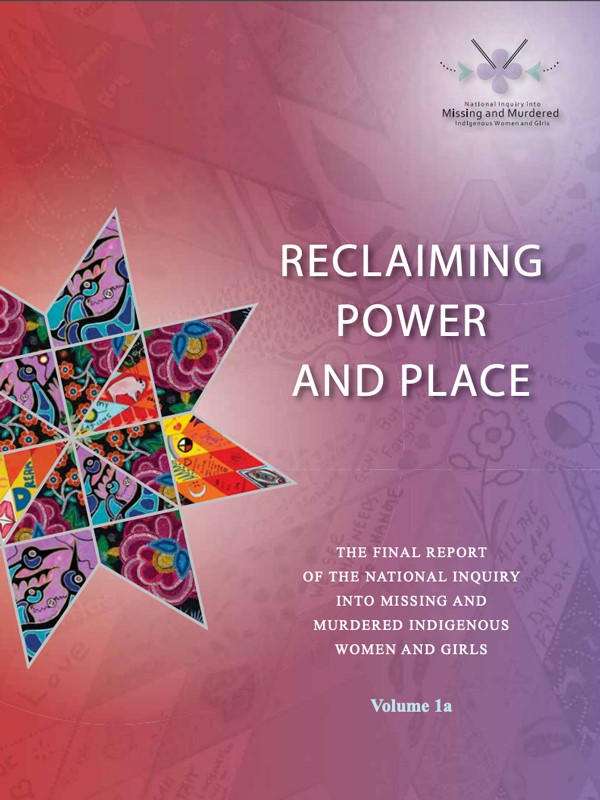
“We call upon all elementary, secondary and post-secondary institutions and education authorities to educate and provide awareness to the public about missing and murdered Indigenous women, girls and 2SLGBTQQIA people, and about the issues and root causes of violence they experience. All curriculum development and programming should be done in partnership with Indigenous Peoples, especially Indigenous women, girls and 2SLGBTQQIA people. Such education and awareness must include historical and current truths about the genocide against Indigenous Peoples through state laws, policies, and colonial practices. It should include, but not be limited to, teaching Indigenous history, law and practices from Indigenous perspectives and the use of Their Voices Will Guide Us with children and youth.”
“We call upon all educational service providers to develop and implement awareness and education programs for Indigenous children and youth on the issue of grooming for exploitation and sexual exploitation.”
Further educate yourself about MMIWG2S
MMIWG2S should not only be remembered and honoured on May 5. The TMU community is encouraged to educate yourself by delving into accurate sources about MMWIG2S. Suggested resources to explore:
- AJ+ | Canada's missing and murdered Indigenous women (external link)
- Assembly of First Nations | Explore MMIWG (external link)
- Brianna Olson-Pitawanakwat and Cyndy Baskin | In Between the Missing and Murdered: The Need for Indigenous-Led Responses to Trafficking (external link)
- CBC Kids | Red Dress Day: What it is and how it began (external link)
- Courtney Skye | Yellowhead Institute: Can the Missing and Murdered Indigenous Women and Girl’s Inquiry be Reclaimed? (external link)
- Pamela Palmater | Series of 13 educational videos to help you understand the Missing and Murdered Indigenous Women and Girls National Inquiry (external link)
- KAIROS Canada | Missing and Murdered Indigenous Women Advocacy and Action (external link)
- Jamie Black | The REDress Project (external link)
- National Inquiry into Missing and Murdered Indigenous Women and Girls | Reclaiming Power and Place: The Final Report of the National Inquiry into Missing and Murdered Indigenous Women and Girls (external link)
- National Museum of the American Indian | The REDress Project (external link)
- Native Women's Association of Canada | MMIWG2S+ and Violence Prevention (external link)
- Native Women's Association of Canada | (PDF file) Building on the legacy of the NWAC Faceless Doll Project - Create your own Faceless Dolls (external link)
- Nickita Longman | Yellowhead Institute: MMIWG2S+ and the Failure of Policing (external link)
- Shades of Our Sisters | Online exhibit (external link)
The resources above were compiled as part of the Red Dress Day e-campaign developed by members of the Rebirthed Teachings Community Learning Circles, in partnership with the Centre for Excellence in Learning and Teaching (CELT), Indigenous Initiatives in the Office of the Vice-President, Equity and Community Inclusion, TMU Libraries and the President’s Office.
Thank you for joining this year’s event
To commemorate this day, on May 5 and 6, 2024, TMU held its first outdoor Msko-mjigoodenh Zhinoomaagewin / Red Dress Exhibit. The exhibit was a visible reminder, bringing forth awareness of the targeted gendered and racialized crimes against the Indigenous Peoples.
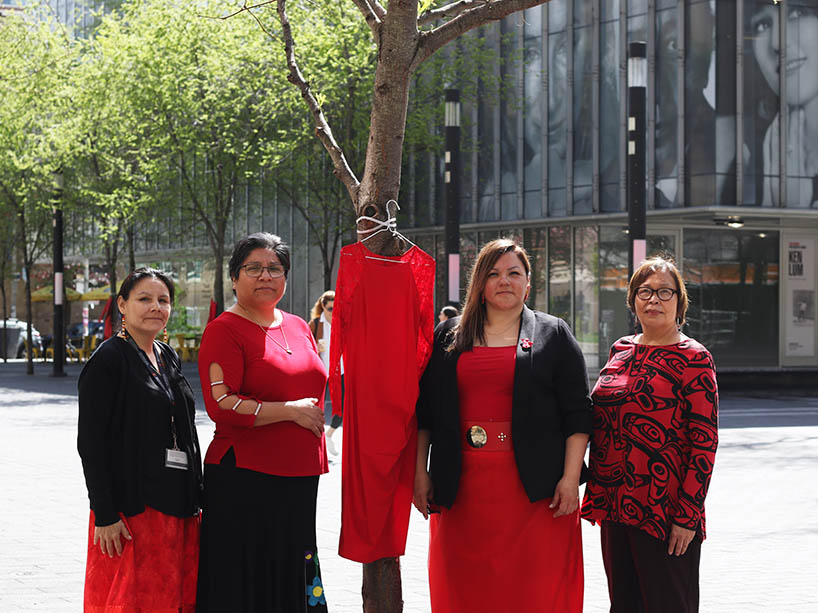
Four Indigenous women staff members at TMU led the work to bring together the campaign and exhibits to honour Red Dress Day. Many other staff and partners supported this work. Pictured from left: Cher Trudeau, administrative coordinator, Indigenous Education Council and Indigenous Initiatives; Amy Desjarlais, lead, Rebirthed Teachings, Indigenous Initiatives; Crystal Osawamick, manager, Indigenous events and special projects, University Events and Ceremonies; and Monica McKay, director, Indigenous Initiatives. All photos by the Office of the Vice-President, Equity and Community Inclusion (OVPECI).
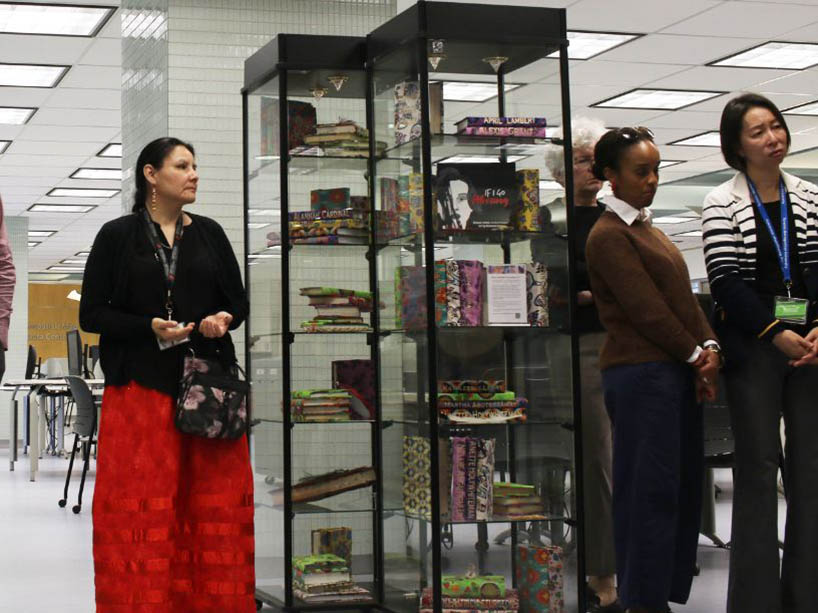
To begin the day’s events, TMU Libraries unveiled the micro gallery, which acts as a memorial to all MMIWGM2S. The gallery, located on the main floor of the main library, comprised books wrapped with fabric sourced from Indigenous vendors. The installation is part of The Canadian Library project to respect and honour the thousands of missing and murdered Indigenous women, girls, men and two-spirit people.
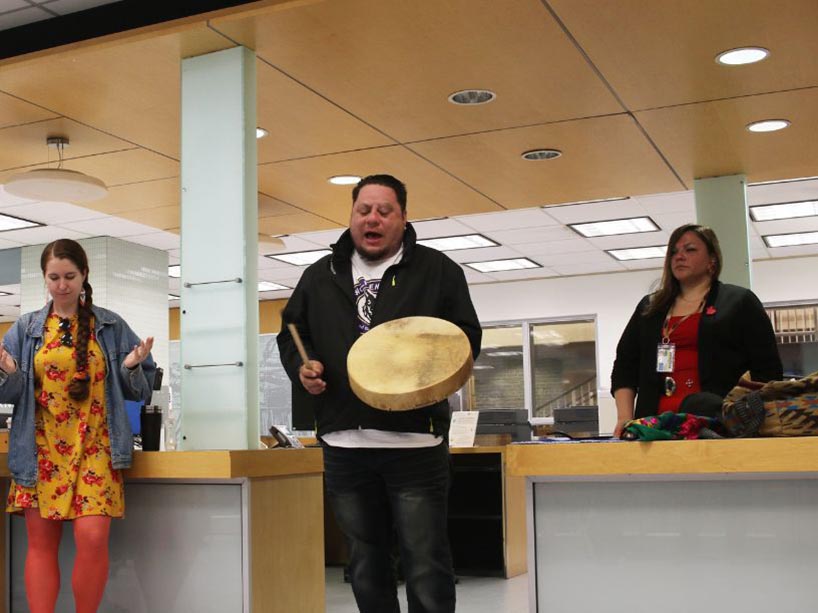
Wayne Moberly (centre) opened the micro gallery exhibit with an honour song. Crystal Osawamick (right), noted the importance of balance and included men on this day to raise awareness and honour the many men that have also gone missing and been murdered.
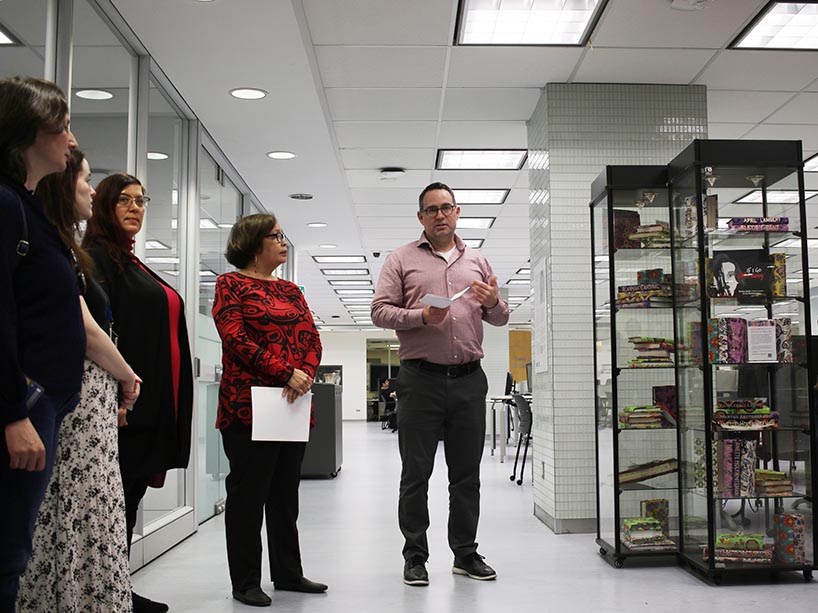
TMU leaders and the event organizers provided welcome remarks. Speakers included Monica McKay (centre-left), director of the Indigenous Initiatives unit in the OVPECI as well as the dean of Libraries, Mark Robertson (centre).
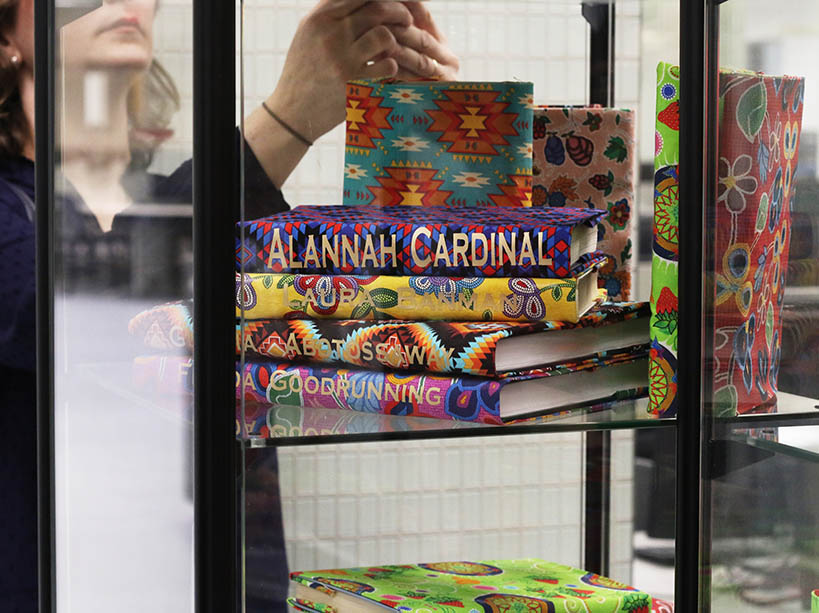
The books in the micro gallery were wrapped by students, staff and librarians during book wrapping events in March at the Libraries’ Digital Media Experience Lab. Some of the books were marked with the names of missing and murdered Indigenous women and girls printed in gold on the spine.
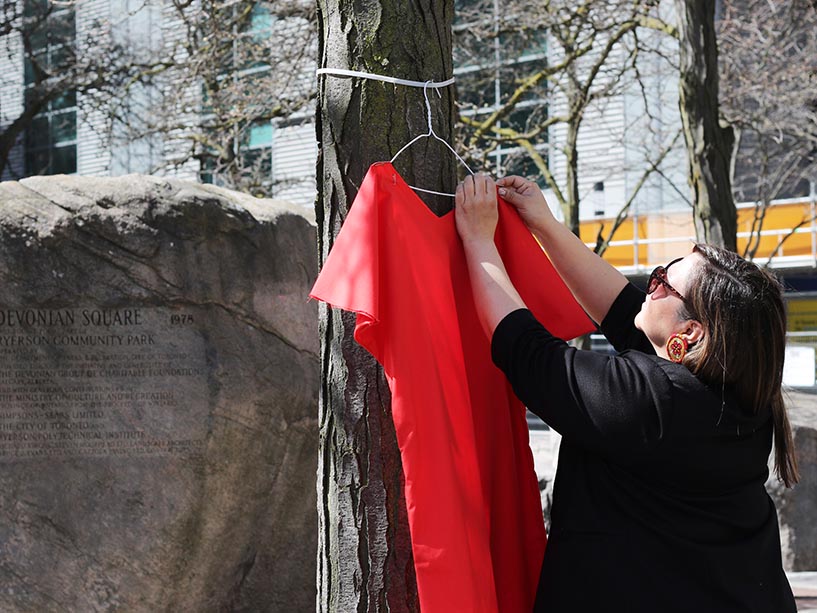
Zhinoomaagewin, in anishinaabemowin (Ojibway/Odawa) language, means a showing. As part of the outdoor exhibit at TMU, red dresses were hung in trees along Gould street. Crystal Osawamick (right), organized and led the installation. She smudged the dresses before hanging them with care and concluded the exhibit with a small feast offering of berries, water and tobacco. The displaying of red dresses in public spaces began in 2010 when Métis artist Jamie Black launched the REDress Project (external link) . The dresses symbolize the absence of Indigenous women and girls who have gone missing or have been murdered and aim to raise awareness about this pressing issue.
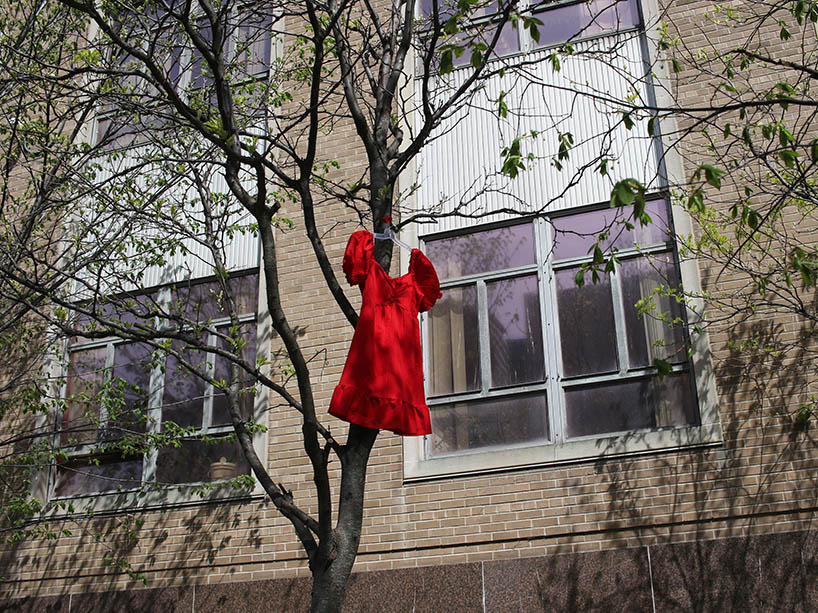
The exhibit of red dresses strung along Gould street was a visible reminder of the targeted crimes against Indigenous women, girls and two-spirit people.
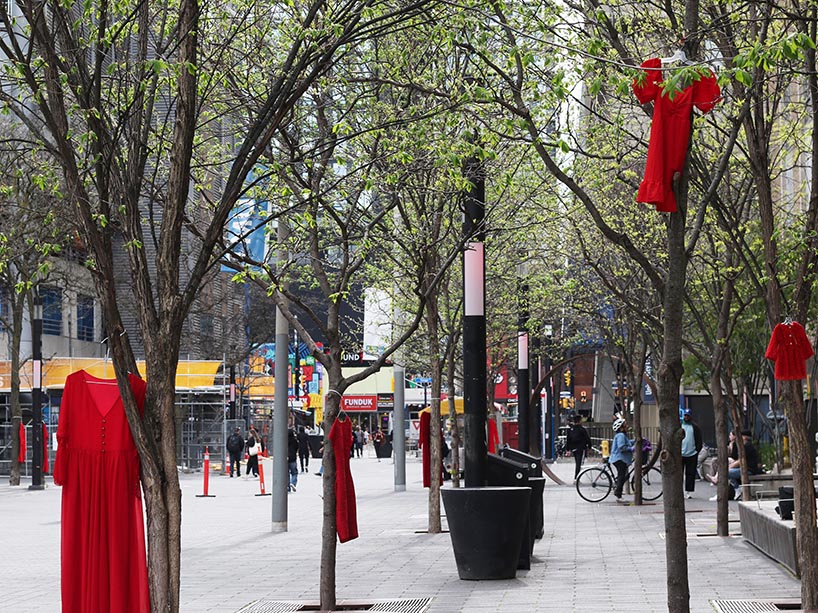
The word ‘redress’ means to remedy or set right. The display of red dresses in public spaces is meant not just as a memorial for MMIWG2S, but as a call to action (Native Women’s Association of Canada).